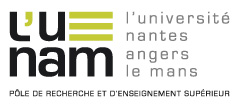Characterization and modeling of elastomers under tension/torsion small dynamic oscillations superimposed on large static preload
Résumé
Introduction Elastomers are widely used in industry for their anti-vibration properties. One of these applications concerns engine mounts, which are subjected to complex multiaxial loading conditions. In order to take into account this aspect, it has been chosen to focus on tension/torsion experiments. Indeed, performing tension/torsion tests allows to assess several multiaxial states with a unique specimen and a unique testing machine. Besides, typical loading conditions for engine mounts consist in vibrations, caused by either perturbation from the road or excitation of the engine, superimposed on a static preload due to the weight of the engine. Objectives The behavior of elastomers under small dynamic oscillations around a large static preload has received particular attention in the 1960s (for example [1]), and new studies have been recently developed ([2], [3]). The present work is based on Huber & Tsakmakis work ([4]), who studied two finite viscolelastic models (A and B). The main objective is to present multiaxial dynamic experimental results, and to confront them to the linearization of Models A and B. Methodology The used specimen is a dumbbell with a large perfectly cylindrical part. It has been specially designed for large tension/torsion tests. First, a quasi-static step with large strains is performed, applying tension, compression, torsion or combined tension/torsion. Then, small sinusoidal oscillations under tension or torsion are performed. Frequency is fixed and varies between 0.1 Hz and 30 Hz. This second step is applied either after maintaining the preload during one hour, or right after the end of the first step. Results and analysis The efficiency of presented models in predicting the dynamic response of an elastomer around an equilibrium position is discussed. The strain decomposition of Model A is easier to apply in this case, but it is also more restrictive than Model B. Indeed, Model A does not take into account any effects of static preload on viscous response of the oscillations, while Model B does.
Origine : Fichiers produits par l'(les) auteur(s)

